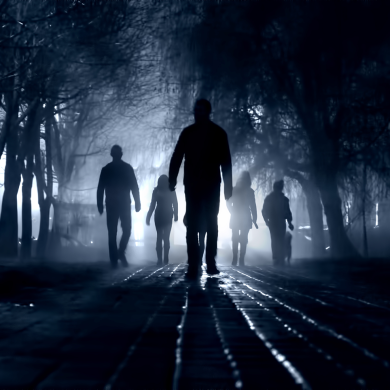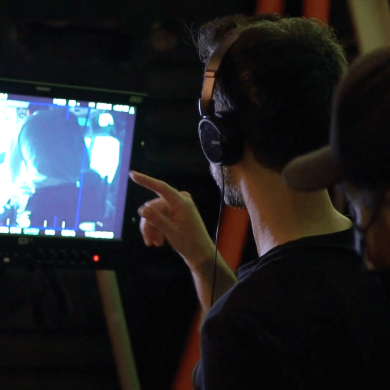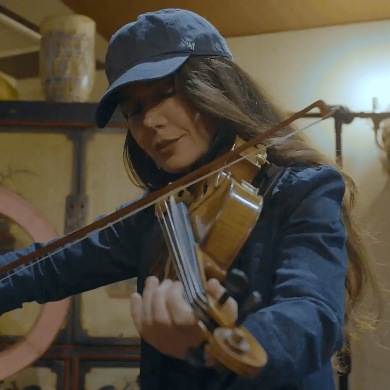After winning three Latino Alternative Theater Awards for “Hamlet in Harlem” (Best Production, Direction, and Ensemble) Alberto Ferreras refuses to sit on his hands.
He is planning to bring the show back before the end of the 2023 and is also scheduled to premiere a new show in February 2024. “A Little Miracle” will be an immersive off-off Broadway musical experience at the legendary Theater For The New City in Manhattan, NY.
Additionally, Ferreras’s video installation “Somos” will continue to be on exhibition at the Molina Gallery of the National Museum of American History in Washington, D.C. through 2025. AND, he is currently Creative Executive in Residence at Así Studios – Televisa Univision, and Learner in Residence at Spring Point Partners, where he is developing an audiovisual project about Latino history in the United States.
Ferreras is tough, persistent, focused, and unwavering – in other words, a New Yorker, who generously sat with CreativeFuture to discuss his multifaceted life.
JC Taylor: Alberto, you’re an artist in many facets – writer, filmmaker, documentarian, and content creator. Tell me about how you first got interested in this wide range of creative arts.
Alberto Ferreras: I think my early interest in art came from the fact that I’m really near-sighted. I was always bad at sports!
Instead, I just focused on things I could hold up to my face: a book, an album, sitting close to the television, stuff like that. So, growing up, I had this fascination with the arts.
JC: Did you come from a creative family?
AF: My father was a big fan of the arts, and he certainly encouraged our creativity. But my mom has no interest in that sort of thing. It was a nice balance in our household; my father supported our artistic endeavors, and my mom was always making sure we knew how to support ourselves. My father was a more of an ethereal thinker, and my mother was a better manager. She was a smart businesswoman.
JC: Do you think those were good skills that you inherited from your parents?
AF: I’m very thankful to have a little bit of both of my parents in me. One can come to the rescue when the other is not available. The shortcomings of an artist can be made up by the talents of the businessperson. At the end of the day, art is an industry, even if you’re trying to change the world with it.
JC: A lot of your work deals with modern social issues. Did you always have that goal of activism when you first started getting into art?
AF: Well, I’ve always believed that a good piece of art or entertainment holds solutions to real problems that we all have. I watch a film because there is something that draws me in, and it usually comes in the form of an emotion, and a film allows you to experience that emotion in a safe environment. Or the film resonates with me because it speaks to an experience that I’ve lived through. So, I try to apply those ideas to my own work, and the result of that is that it usually does speak to some real-world issue.
JC: I notice that you choose to work in black and white a lot. Can you tell me about the thought process behind that?
AF: First, I think it’s beautiful. I’ve always loved black and white movies. I think because there’s less information, you can focus on the substance of what’s before you. You aren’t focused on the bright colors in the frame, you’re focused on the words you’re hearing or the intention behind the action you’re seeing.
JC: Who’s someone that you look to for inspiration?
AF: I might sound like Ed Wood here, but I really like Orson Welles. Bob Fosse was a genius. Ridley Scott, mostly because Blade Runner is the movie that I’ve seen more times than any other. These days I find it difficult to keep up with a lot of artists who are currently active. I can tell you there are plenty of Latin American writers that we don’t pay enough attention to in American culture like Gabriel Garcia Marquez or Jorge Luis Borges that were hugely influential on me personally.
And then there are also lesser-known artists like Juan Carlos Gené that have had an enormous effect on me. I have a play right now off-Broadway that is in large part attributed to what Gené taught me when I was his student 30-40 years ago as a teenager in Venezuela. He was this genius who taught me so much about what I know about dramatic structure and storytelling, and every day I wish that I had paid closer attention!
JC: Is that play Hamlet in Harlem?
AF: Yes! Theater for the New City, which is a very interesting institution that dates to the seventies, saw potential in the play. They’re really interesting, because even as an organization that has given a start to all-time great artists like Sam Shepard. They’re just as subversive today as they were in the seventies. Together with them, we were able to secure a grant from New York City Artist Corps, which is one of the cool things they were doing in New York to support the arts during the pandemic.
JC: So, for our readers who aren’t familiar, what is Hamlet in Harlem all about?
AF: Hamlet in Harlem is the story of a young white filmmaker who has a very good heart, and he wants to do an all-Latino version of Hamlet. The only problem is, he doesn’t know a lot about Latinos, and he doesn’t know crap about Hamlet.
So his father, who is a Hollywood producer, puts together a reading for the investors, and they bring in all these Latino actors who start questioning the script, because it has one too many cliches and stereotypes. And these actors start re-writing the script.
Like in anything else I do with my work, this play is not just about addressing a problem, but also about finding a solution. This is a story about trying to build a bridge between the Latino community and the non-Latino communities.
JC: Let me ask you about some of the other works you have right now. Somos is a video installation commissioned by the National Museum of the American Latino. How did that project come about?
AF: Before this museum even existed, the Smithsonian was working on figuring out what sort of exhibits they wanted to house in this new collection of Latino Art within the National Museum of American History. They enjoyed my work on Habla, which is a show that I’ve been doing for HBO for 20 years, and they could see that I had a gift for turning the camera to capture stories of U.S. Latinos. So, we discussed the process of creating a video installation that sort of explained the Latino identity – not just for non-Latinos, but for Latinos that didn’t necessarily have these conversations about their identity.
Basically, it’s a 15-minute video in which we have nineteen guests talking about their experience, either immigrating to the U.S. or just their experience growing up here. It’s this kaleidoscopic view of the Latino experience in the U.S.
JC: Sounds like a difficult concept to pack into just 15 minutes.
AF: I think we did a good job given the limitations, because we’ve received a lot of praise, and it’s helped the museum a lot. As a filmmaker, there’s nothing more addicting than watching people watch your work. So, going to the gallery and seeing how people connect with this short video installation has been a really special experience for me.
JC: You mentioned Habla. It’s a large portion of your life that you’ve dedicated to that series. How did that come about, and how have you seen it change in the time that you’ve working on it?
AF: One of the crazy things that surprised me when I came to the United States was the Latino presence. I had no idea that there were so many Latinos. I didn’t know much about the Puerto Rican experience, or the Nuyorican experience, or the Chicano experience for that matter. I didn’t understand that there were a lot of Latinos in the U.S., because I didn’t see them on TV or film, and that’s where my perception of America came from. The first time I remember seeing U.S. Latinos on screen was when I saw La Bamba, and that was thirty years ago at this point.
Anyway, I was recruited to make this show in Spanish for MTV, and my job was to go out in the street with a camera and microphone and interview people. I found that people were really uncomfortable speaking in front of the camera and expressing bilingualism. At that time, it was uncommon to have Spanish-speaking people in front of an English-speaking audience, so there was an opportunity to show this cultural crossover on TV pretty much for the first time.
I pitched the idea to my boss that we would have a show where we would give people the opportunity to speak in Spanglish, and to talk about the good and the bad of living the U.S., and that’s how Habla was born. We first did it in 2003, and we felt that it was important enough to do it as a series, so it became a recurring special. That’s what I’ve worked on for 20 years now.
JC: What can you tell us about this latest iteration of the show? I know you’ve spoken to some incredible people.
AF: The most distinctive feature of the Latino community is its diversity and complexity. What every guest on this show has in common is that they address one turning point in their lives. In the case of Congressman Ritchie Torres, he talks about the moment he decided to run for office. In the case of [Pulitzer Prize-winning poet] Natalie Diaz, she talks about the moment she decided she wanted to rescue the language of her tribe, the Mojave people.
We talked to Wilson Cruz about the day he came out to his parents, and what it meant for a Puerto Rican actor to tell his parents that he was gay and how that changed his life. So, these stories are all about transformation.
Carmen Yulin Cruz, who was the mayor of San Juan, discussed Hurricane Maria, which was not just a turning point for her, but for the whole island. When we talk about Latinos, because there is so much diversity, it can become hard to visualize the identity of the community. Habla is about having those conversations.
JC: One of the things I found in preparation for this interview was an introduction you did for Nights of Cabiria on Turner Classic Movies (TCM). Can you tell me about that experience?
AF: I might cry! I’m not sure if I can talk about Nights of Cabiria without crying. It’s one of my favorite Fellini movies.
I was a big fan of TCM, for a long time I would have my television constantly tuned to TCM. Anyway, I heard that they were looking for a fan that could introduce a film, and I chose Nights of Cabiria because that’s a movie that I love, but also because as someone with an accent, it’s always bothered me when people are dismissive of a piece of art because it’s in a different language. So, I wanted to be the one that said, “Just because this film is in a foreign language, doesn’t mean that it won’t touch you, and move you in a meaningful way.”
JC: As someone who’s not from New York, I’ve noticed a lot of conversation about the city after the pandemic and how it has changed. From your perspective as a New Yorker for 30 years, how have you seen the city change?
AF: Tragically, I’m one of those people who really enjoyed New York during the pandemic. It was one of the only times in the city’s history where, for New Yorkers, it felt like the city belonged to us. The sights of the empty streets were so compelling, it actually inspired me to take up photography to capture some of the incredible stuff I was seeing. It allowed me for one thing to appreciate an unobstructed view of the city’s amazing architecture, which I had never had before. The city is returning to how it was before, and that’s great, but it was a unique moment to live through.
JC: What advice would you have for a younger Alberto, or someone who has similar aspirations?
AF: I would tell them to aim high.
Maybe you don’t reach the moon, or the stars, and instead you just land on the roof. But that’s better than being in a ditch down below. Every so often, I’ve aimed high in my career, and it paid off.
You’ve seen my project The Lessons. Well, that was a project that was ultra-low budget, we only had one rehearsal, and we shot it in four hours. That was an idea that I had been obsessed with for a long time, until finally I stopped thinking about it, and just did it.
So to young artists and filmmakers, if you feel very strongly about an idea, then find a way where you can turn it into something real and tangible. Short story, or short film, or podcast, or whatever. It may not look as grand as you saw it in your head, but it’s better than just sitting with the idea forever. You have unprecedented access to technology in this era, so make use of it!



